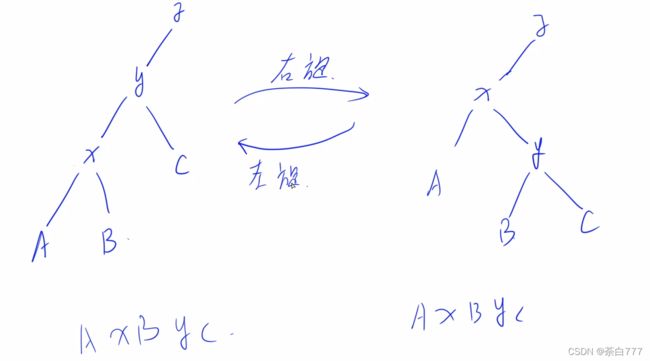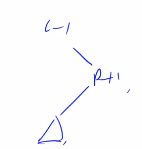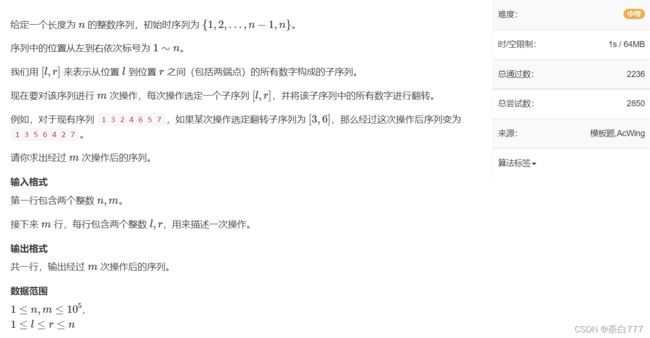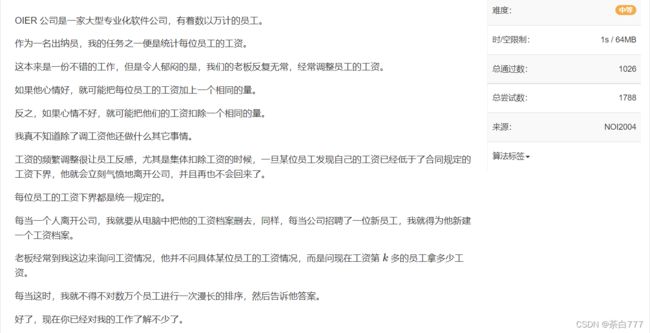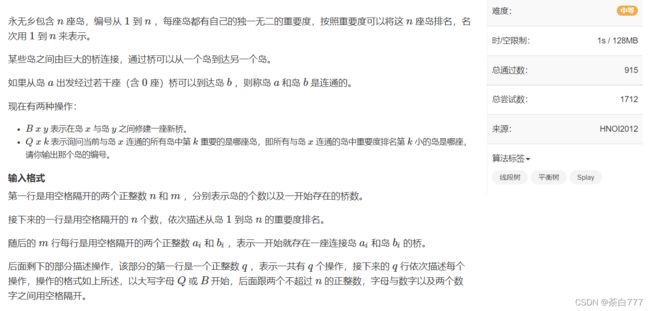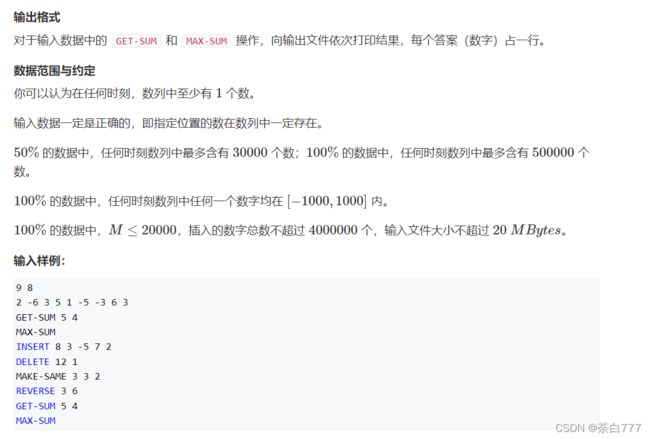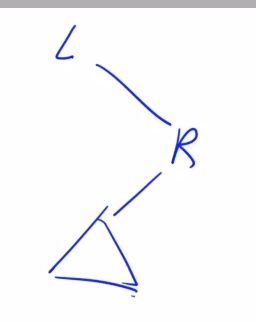Splay
定义
Splay是一颗平衡二叉树,但是往往没那么平衡,期望高度是 l o g ( n ) log(n) log(n)
应用
不仅支持普通平衡树的操作,包括一些区间问题(一般用线段树解决)的也支持;
保证高度的思想
对某个结点进行操作的时候,将其旋转到树根;
这里的操作指的是像插入,查询等等;
也就是说,这跟操作系统的局部性原理类似,某个点既然当前用到了,那么后续肯定还会用到;
拉到根结点其实就是进行了一个类似缓存的操作;
应用这个思想,就能保证平均意义下,一次操作的时间复杂度是 O ( l o g n ) O(logn) O(logn)级别的;
那么这个操作如何实现呢?见下方的Splay操作;
基本操作
查询x的排名
查询前驱
查询后继
左右旋转
Splay操作
Splay(x,k)表示将 x x x旋转到 k k k的下面;
当 k = 0 k=0 k=0时, x x x就变成根了;
分为两大类(对称的情况同理)
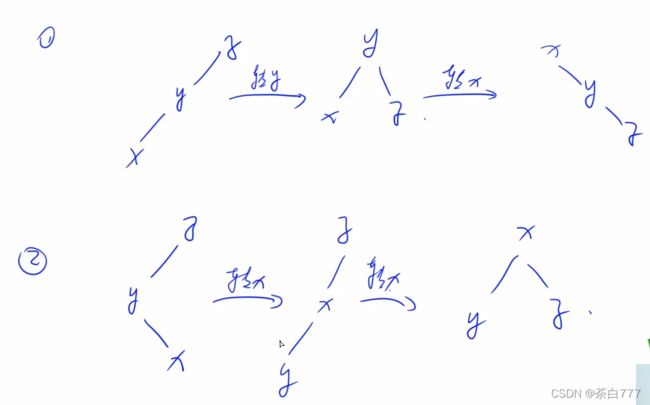
可以发现每操作一次, x x x的高度就+2,不断的迭代直到父节点为 k k k;
一般来说, k k k只会取 0 0 0,以及根结点这两种情况;
插入一段序列
比如说我们要将某个序列插入 y y y的后面,在中序遍历中, y y y的后继是 z z z;
- S p l a y ( y , 0 ) Splay(y,0) Splay(y,0)
- S p l a y ( z , y ) Splay(z,y) Splay(z,y)
- 将整个序列构造成一棵二叉树插入 z z z的左子树;
因为 z z z是 y y y的后继,那么其左子树必然为空(不然不符合中序遍历)
建树
偷懒的方法,就直接搞成一条链(特殊的Splay,但是效率低)
常规的方法,取中点设为rt,然后递归建立左右区间;
删除一段序列
假设要删除 [ L , R ] [L,R] [L,R]这一段;
找到 L L L的前驱 L − 1 L-1 L−1,找到 R R R的后继 R + 1 R+1 R+1;
- S p l a y ( L − 1 , 0 ) Splay(L-1,0) Splay(L−1,0)
- S p l a y ( R + 1 , L − 1 ) Splay(R+1,L-1) Splay(R+1,L−1)
- 删去 R + 1 R+1 R+1的左子树(变成NULL即可);
旋转前两步以后, [ L , R ] [L,R] [L,R]就是 R + 1 R+1 R+1的左子树了;
push_up
和线段树类似,用子节点的信息来维护父节点;
当旋转的时候使用;
push_down
和线段树类似,传递懒标记;
当访问子节点的时候使用;
合并两颗Splay
注意要求, x x x树的最大值小于 y y y树的最小值;

其实就是按照BST的规则插入;
其他操作
其他操作就和普通的平衡树一样;
注意
Splay是一颗BST,但是要时刻注意排序的关键字是什么;
如果仅仅涉及仅仅涉及到旋转、插入节点、删除节点、分裂树、合并树这些操作是符合常规BST的;
但对于我们的例题一Splay来说,此时排序的关键字是序列下标,那么对于序列中元素的值就不一定满足BST性质了;
Splay时时刻刻保证中序遍历是当前序列的顺序,但是并不能保证是有序的;
一般来说,涉及删除操作,我们通常会加入两个哨兵;
当删除的时候,一般会取前一个点和后一个点;
那么加入哨兵就可以防止越界了;
例题
Splay
传送门
题面
思路
这题Splay的用法类似于线段树,我们维护的是一个序列(不一定有序);
维护信息
1.子树总点数 size 用于递归查找位置
2.懒标记 flag 整个区间是否需要翻转
其他操作上面已经提到了,或者就是常规平衡树写法;
Code
#include 郁闷的出纳员
传送门
题面
思路
这题跟上题不同,这题Splay维护的类似传统平衡树;
维护的是一个有序的序列;
题目要求以下几种操作;
- 插入
- 集体涨薪
- 集体降薪
- 剩余员工中找第k大
因为降薪后某些员工会离职,因此我们还需要支持区间删除这个操作;
因为涨薪和降薪都是集体的,因此我们维护一个偏移量offset即可;
每个员工的工资则为salary + offset;
离职的问题,我们可以找到某个员工的工资恰好满足salary + offset ≥ min_salary;
然后引入两个哨兵放在开头和结尾;
然后直接进行区间删除即可,上面有提到;
Code
#include 永无乡
传送门
题面
思路
这题的Splay是按照重要程度为排序关键字;
题目要求我们支持两种操作;
- 合并两个集合
- 动态查询某个集合中第 k k k小
合并集合的话,我们可以考虑使用并查集来完成;
第 k k k小我们可以考虑使用Splay来完成;
但是如果暴力合并所有的Splay,时间复杂度是 O ( n 2 l o g n ) O(n^2logn) O(n2logn)的;
这里有一个常用的技巧——启发式合并(按秩合并)
我们每次都将小的集合合并到大的集合中;
合并Splay树也按这个顺序,时间复杂度就可以优化到 O ( n l o g 2 n ) O(nlog^2n) O(nlog2n)
启发式合并的时间复杂度是 O ( n l o g n ) O(nlogn) O(nlogn),然后我们插入操作是 O ( l o g n ) O(logn) O(logn);
合并过程也很暴力,遍历某棵被合并树,然后将其上面的结点一个个insert到目标树;
Code
#include 维护数列
传送门
题面
思路
这题我们的排序关键字是下标,也就是不维护一个有序序列;
- 区间修改,那么需要一个懒标记
cover; - 区间翻转,那么需要一个懒标记
rev; - 区间求和,那么需要维护一个
sum来表示; - 最大子段和,类似线段树;维护最长前缀
ls,最长后缀rs,最大子段和ms; - 插入、删除;那么需要找第 k k k个元素;也就是说需要维护一个元素个数
sz;
注意这里有一个需要注意的点;
当打上懒标记以后,我们维护的是修改后的值;
为什么上面的例题Splay不需要呢?
那题虽然也有一个翻转懒标记,但是翻转以后并不影响另一个信息sz的值;
但是这题不同,你翻转了以后,甚至区间修改了以后;
ls,rs,ms,sum可能都会改变的;
因此我们需要规定好;
因为题目没有明确说明最多可能存在的点;
为了防止MLE,我们考虑时间换空间;
引入内存回收,也就是搞一个数组,存可以分配的位置;
每当删除的时候,我们就把这整段放入这个回收数组;
当然TLE的话还是空间换时间吧
Code
#include 注意
代码中没有在rotate和splay函数中push_down,是因为我们在进行rotate和splay之前的kth中已经下传标记了;
总结
Splay既可以像线段树一样维护序列,也可以像普通平衡树一样维护有序序列;
维护有序序列的排序关键字是val,而维护序列的排序关键字则是下标;
很容易理解,因为Splay总是维护一个合法的中序遍历;
维护有序序列的时候,中序遍历自然就是排好序的;
而维护下标的时候,其实就跟线段树一样,中序遍历是一段连续的区间;
当更新完子节点,记得push_up;
当访问子节点的时候,记得push_down;
Splay维护区间信息都是这么个流程;
比如我们要搞 [ L + 1 , R − 1 ] [L+1,R-1] [L+1,R−1],那么找到 L L L, R R R;
将 L L L搞到根,将 R R R变成 L L L的右儿子;
然后区间 [ L + 1 , R − 1 ] [L+1,R-1] [L+1,R−1]就在 R R R的左儿子了;
当然你也可以对称的搞,将 R R R放到根, L L L放到 R R R的左子树,那么区间 [ L + 1 , R − 1 ] [L+1,R-1] [L+1,R−1]就在 L L L的右子树了;
参考
- Acwing
- OI-WiKi



